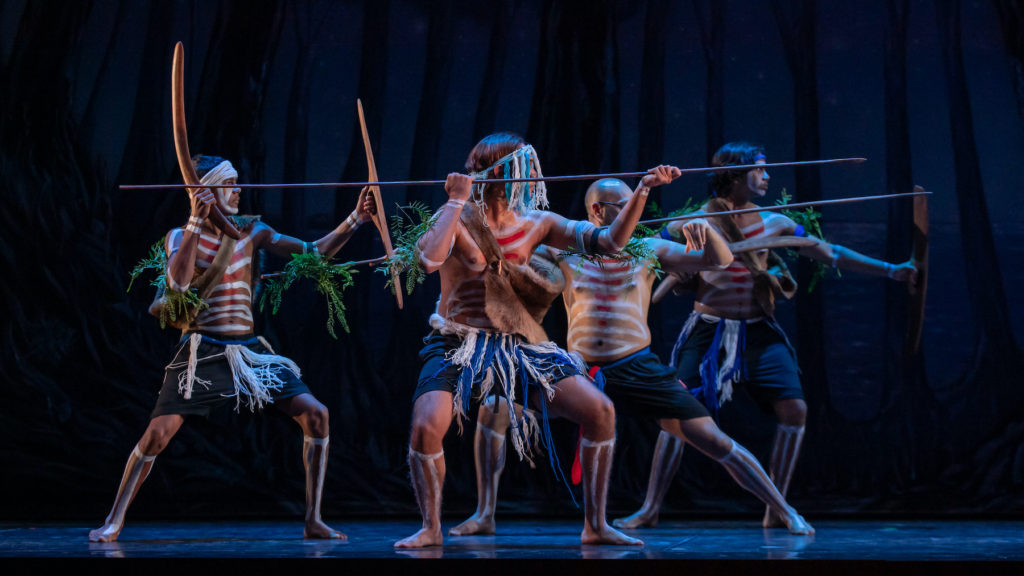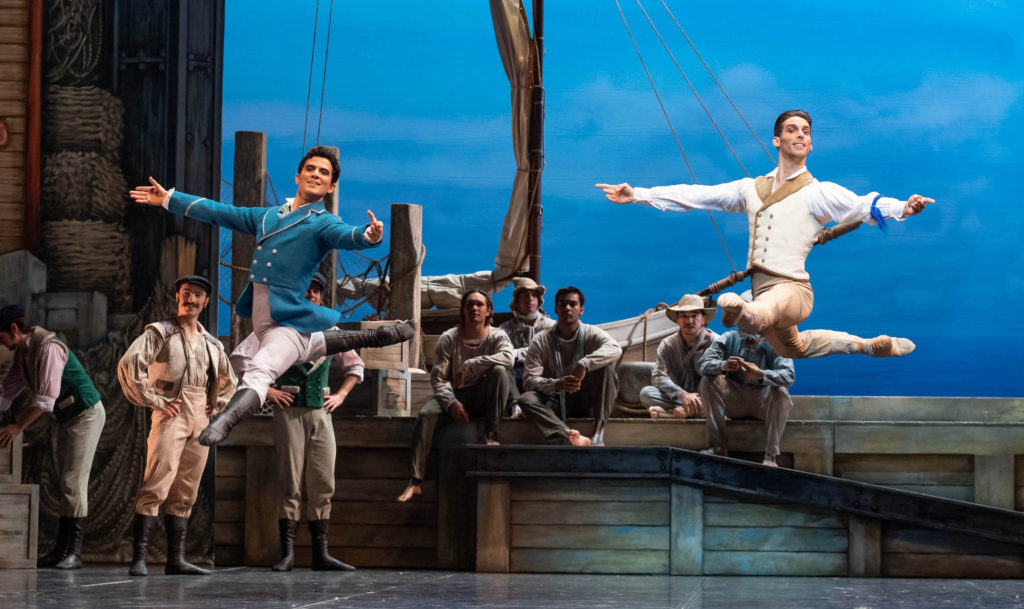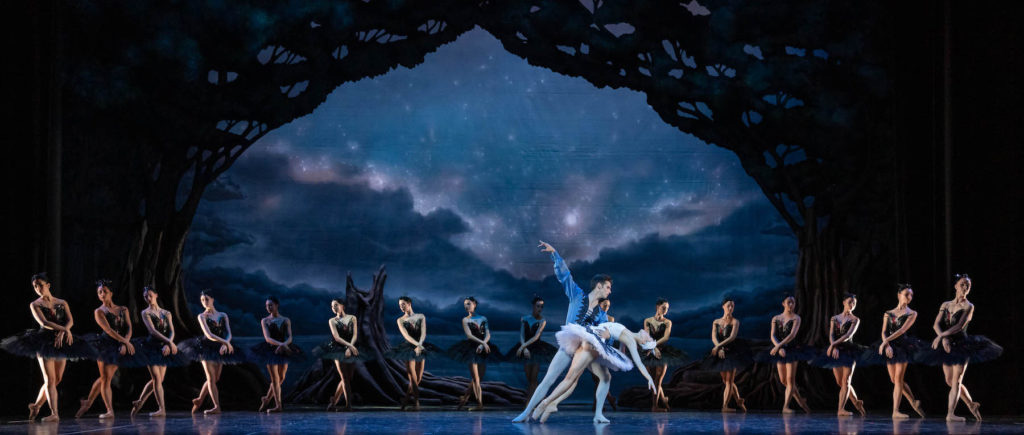West Australian Ballet: In Noongar country, real black swans live by a real Swan River - Vancouver Ballet Society
- Home
- Reviews 2020 - 2023
- West Australian Ballet: In Noongar country, real black swans live by a real Swan River

By Deborah Jones
A conventional production would have been the safe way to go when staging the first Swan Lake in West Australian Ballet’s 70-year history. Artistic director Aurélien Scannella had other ideas. His company is based in Perth, a city strung along the Swan River in Noongar country. How might local Aboriginal stories and dance fruitfully inform the legend of a woman-swan and the man who loved her?
As the name of the Swan River suggests, there was already a link — a particularly potent one. The swans here are black, native to this place, and are the totem of the Noongar Beelier, or people of the Swan River. In close consultation with Noongar leader Barry McGuire, the decision was taken to weave this knowledge tightly into the fabric of the ballet.

Swan Lake premiered on November 18 in Perth, at His Majesty’s Theatre. Before the first notes of Tchaikovsky’s score were played, a group of Noongar Beelier gathered under a star-filled sky, protectively guarding Odette in a flash forward to the end of Act II. Summoned by the Spirit of the Earth, sung by McGuire, the members of Gya Ngoop Keeninyarra (One Blood Dancers) performed their Black Swan dance. It had not been seen publicly in more than a century.
The soul of the piece was there, right from the start.
In Polish choreographer Krzysztof Pastor’s libretto, the narrative was now one of colonials settling in Perth in the 1800s, some wanting to make their fortunes by appropriating Noongar land along the banks of the Swan. There wasn’t a palace within sight, and Prince Siegfried was now Sebastian, a young man sympathetic to the Noongar and their spiritual connection to country.

Pastor retained the ballet’s broad outline along with large swathes of traditional choreography while integrating the Noongar story sensitively into the drama. Gya Ngoop Keeninyarra appeared at pivotal moments in the waterside second and fourth acts. A new character, Noongar Elder Mowadji, straddled the ballet’s two worlds. Sebastian’s great friend, he was comfortable mixing with the colonists although not accepted by all. The disdain of Sebastian’s father made that clear.
The first act took place in Fremantle, the bustling port at the mouth of the Swan River. The well-known pas de trois looked fresh and exuberant in designer Phil R. Daniels’s sunny setting. Here the dance wasn’t undertaken to please a prince but to work off youthful high spirits, which Julio Blanes, Claire Voss and Mayume Noguromi had in abundance. Oscar Valdés’ clean-limbed, high-flying Sebastian joined in seamlessly from time to time as Mowadji (charismatic guest artist Kyle Morrison) watched on.
Pastor played fast and loose by relocating Russian and Hungarian national dances to the first act but it wasn’t a bad idea, strengthening the sense of old Europe excited by the prospects in this new — to the Europeans — place.

Pastor also split the roles of Odette (Kiki Saito on opening night) and Odile (Chihiro Nomura) so he could introduce Odile early. The daughter of a business associate of Sebastian’s father, she was thrust forward as a good match for the reluctant young man.
The exquisite Act II, substantially unaltered, was elevated by the watchful Noongar presence at beginning and end, and by Charles Cusack Smith’s stunning black tutus for the ensemble of swans, who looked unusually authoritative. Glamorous, too, with the glittering touches of red that referred to black swans’ red beaks. Von Rothbart became The Eagle (Matthew Lehmann), a forbidding figure associated with Odile’s father and based on the mighty wedge-tailed eagle, another native bird. It was an inspired choice for a narrative in which the supernatural and natural worlds are inextricably linked. When The Eagle attacked Odette at the close of the act, white feathers swirled as if torn from her body, a visual telling of the Noongar story of how white birds became black. Later in the ballet, Odette’s tutu would reflect that transition.
On opening night, the rafters rang for Saito. The following night, Dayana Hardy Acuña, intense and sorrowing, was entirely different and equally affecting. Predictably and deservedly, on both nights the Cygnets were cheered to the echo.
Unfortunately, no number of Odile’s showpiece fouettés could compensate for Act III’s shortcomings. Nomura’s vulgar Odile could not have been less like Saito’s delicate Odette as she vamped cartoonishly, having inexplicably entered the party with a troupe of Spanish dancers. The necessary suspension of disbelief at this crucial point was impossible, particularly as Odile was decked out in a vast, white-feathered cape more suited to an Antarctic expedition than a Perth party.

In the second cast, Carina Roberts’ Odile was less obviously scheming, and the considerable experience of veteran principal Lehmann, the second-cast Sebastian, helped mitigate things a little. But Sebastian, already a less forceful figure than Morrison’s Mowadji, looked foolish to be so taken in by Odile.
Pluses, though, outweighed minuses by a large degree. Swan Lake cast a strong visual spell, particularly in the second and fourth acts gorgeously lit by Jon Buswell, and the company was absolutely ready to tackle this Everest of ballets (it fielded four casts). Best of all was their confidence that telling Swan Lake this way would honour both the work and the community in which it was performed.
As the last bars of Tchaikovsky were played, McGuire’s voice once more rang out and the Noongar Beeliar stood on their land with Sebastian gathered in their arms. It was a profoundly beautiful ending to a Swan Lake like no other.

